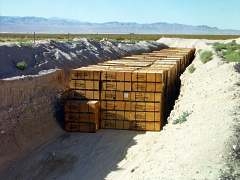|
 Remediation
of Nuclear Waste Remediation
of Nuclear Waste
Since
the dawn of the nuclear age, no solution has been found
to the safe disposal of the highly radioactive and toxic
waste produced by Nuclear Power Stations. 12,000 tonnes
of spent fuel is produced annually.
Thousands
of tonnes of these deadly substances are still stored
in "temporary" facilities at nuclear installations
around the globe. The exact quantities and status of
this waste is often unknown.
In
some cases, the waste is so dangerous that it cannot
be approached or disturbed. An example of this is the
infamous building B12 at Sellafield in the UK.
Production
of Electricity from Nuclear Waste
In
the 1990s, CERN conducted experimental tests on a concept
developed by Dr Carlo Rubbia he has called the Energy
Amplifier. The EA uses the concept of Accelerator
Driven Fission to disintegrate radioactive
substances by bombarding them with high energy neutrons.
Excess energy is released by the nuclear reaction which
can be used to produce electricity and run the initiating
neutron accelerator. It is a sub-critical fast neutron
system, as opposed to a conventional fission reactor
which operates on the principle of a chain reaction
sustained by slow neutron emission.
This
improvement on conventional nuclear fission would allow
current nuclear waste to be burned up as fuel in an
Energy Amplifier to produce electricity. The waste products
are radioactive but short lived and so decay away to
stable harmless end products quickly. Other long lived
waste can be rendered harmless by the Energy Amplifier
using the system of Adiabatic Resonance Crossing, which
was experimentally tested at CERN in an experiment called
TARC. Other experimental verifications called FEAT,
MUSE and MEGAPIE have also been carried out.
FEAT
was the First Energy Amplifier Test, carried out under
Rubbia direction at CERN. This verified the principle
in a test that was limited to a power output of 1W.
TARC
was the second set of experiments carried out under
Rubbia to examine Adiabatic Resonance Crossing of neutrons
in a lead matrix with samples of Technetium 99. The
experiments showed that ARC is a viable and powerful
method of neutralising nuclei showing resonances, which
is the case for all nuclei in nuclear waste management.
The
Energy Amplifier concept has two other advantages: it
is a sub-critical system which cannot enter into a critical
chain reaction or Chernobyl type reactor meltdown and
it does not produce plutonium waste that could then
in turn be used to manufacture atomic weapons. Therefore
it only has civil applications - energy and medical
uses - and cannot be used for military purposes. This
could make it an ideal form of nuclear power that could
provide an answer to nuclear weapons proliferation concerns.
Research
in the USA has lagged behind, with no experimental tests
carried out to date as far as we know. Research is also
being carried out in Japan and Russia into this concept.
References
1.
"Conceptual Design of a Fast Neutron Operated High
Power Energy Amplifier", CERN AT 95-44, 29/9/95,
DR Carlo Rubbia.
2.
"Design of an Accelerator
Driven System for the Destruction of Nuclear Waste",
Y. Kadi, JP Revol, 3-7/9/01, Lectures given at the Workshop
on Hybrid Nuclear Systems for Energy Production, Trieste.
3.
"Conception of Secure Atomic
Energy Plant with Sub Critical Reactor and 100meV
Proton Accelerator", AN Didenko, AD Koljaskin,
GL Horasanov, VE Kalantarov (Downloaded from CERN website)
4.
Laser Driven Photo Transmutation of 129 I - a long lived
nuclear waste product, Ledingham et al., J. Phys. D.,
Appl. Phys., 36 (2003), L.79 - 82.
5.
The Photon Reactor:
Producing Power by Burning Nuclear Waste, Dr Paul Brown,
Nuclear Solutions LLC.
Battery
Motors Atmospheric
|
